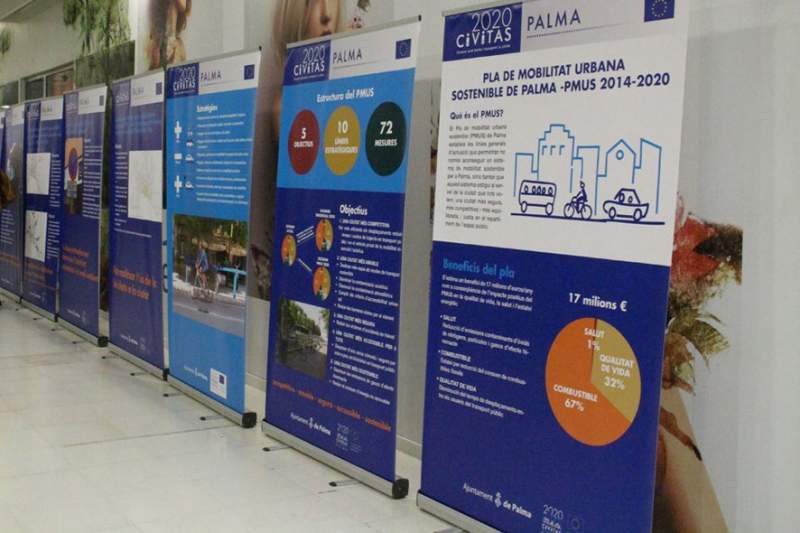Dynamic Sustainable Urban Mobility Plan
Thematic areas
Integrated & inclusive planning
- Spatial planning / land-use planning
Behavioural change & mobility management
- Mobility Planning
Summary
During the CIVITAS DYN@MO project, Palma developed a sustainable urban mobility plan which integrates existing policies, new policies and strategies for sustainable mobility. The process involves local stakeholders in mobility using innovative processes and web 2.0 tools. Palma has drawn on experiences from the city of Aachen. Studies on new public transport developments and freight distribution were integrated in the planning process. In October 2014, the Palma City Council adopted the final version of its Sustainable Urban Mobility Plan (SUMP) and related action plan.
Implementing sustainable mobility
In 2001, the city conducted a pre-diagnostic study about the mobility situation in Palma. Updates followed in 2009 on sectorial plans for cycling, pedestrian areas and parking. The concepts and strategies had, however, not been approved as an integrated package by the City Council. The existing plans for different transport modes needed to be integrated into a holistic SUMP development process.In 2001, the city conducted a pre-diagnostic study about the mobility situation in Palma. Updates followed in 2009 on sectorial plans for cycling, pedestrian areas and parking. The concepts and strategies had, however, not been approved as an integrated package by the City Council. The existing plans for different transport modes needed to be integrated into a holistic SUMP development process.
The main objectives of this measure were to:
- Develop a Sustainable Urban Mobility Plan for the city of Palma that is in line with the General Urban Master Plan currently under revision.
- Integrate the existing policies and strategies for sustainable mobility into this new policy framework that also incorporates the plans for new infrastructures as well as new strategies, action plans and budget provisions.
- Closely involve all local stakeholders in the field of mobility in developing the SUMP and the related actions/measures, applying different methods from stakeholder meetings, and advancing internet tools for direct input by citizens.
- Conduct a diagnostic study about the local mobility situation and define a set of indicators for monitoring and evaluation of the progress in implementing the SUMP.
- Change the attitude of citizens towards more awareness about the importance and advantages of sustainable urban transport.
Progress
 The city created the mobility stakeholder roundtable to oversee the SUMP process. The stakeholder roundtable was inaugurated by the Mayor in September 2013 and has been meeting regularly during the preparation, definition and implementation phases of the new SUMP.
The city created the mobility stakeholder roundtable to oversee the SUMP process. The stakeholder roundtable was inaugurated by the Mayor in September 2013 and has been meeting regularly during the preparation, definition and implementation phases of the new SUMP.
During the preparation phase the following tasks were executed:
- Demand study for the urban bus network
- Goods distribution inventory: creating a detailed overview of the use of loading and unloading areas.
- Diagnostics study about the mobility situation in the city of Palma
The results of the diagnostics phase were presented to the stakeholder roundtable and a series of workshops was organised to discuss possible actions and measures around six selected themes.
A draft version of the SUMP and its action plan was discussed among stakeholders and political parties during the summer of 2014 to reach a broad consensus for its final version. During this period, citizens also had the opportunity to contribute to and comment on the SUMP.
The final version was prepared in the fall of 2014 and approved by the City Council in October of the same year. The SUMP and its measures, which jointly form the action plan, strived towards achieving a mobility system that represents a more competitive, friendly, sustainable, accessible and safe city by 2020. In order to achieve these goals, the SUMP defined 10 strategic lines which aimed to reduce the use of private vehicles, promote more sustainable modes (public transport, walking and cycling) and integrates essential motorised mobility into the urban environment through cleaner technologies, urban planning and mobility management. The action plans proposed 72 concrete measures. The implementation of the first of these actions has already started.
After having approved the plan, the stakeholder roundtable has continued to monitor the progress of the SUMP's implementation in relation to the performance indicators included in the plan.
Outcomes
Tangible outputs:
- Demand study for the urban bus network
- Goods distribution inventory: a detailed overview of the use of loading and unloading areas.
- Diagnostics study about the mobility situation in the city of Palma
- 16 stakeholder involvement workshops (6 organised in 2014, 6 organised in 2015 and 4 organised in 2015)
- Citizenship contributions through social media channels and CIVITAS dissemination activities
- Online simulation tool for the impact of different modes of transport
- Two awareness campaigns for the public and stakeholders
- Final version of SUMP approved by City Council
- First data collection round for monitoring of the SUMP
- During 2015 Sustainable Mobility Week, the SUMP and its progress was presented to the citizens of Palma in a public event. During the seven days of the European Mobility Week individual citizens were invited to contribute with their comments at the Sustainable Mobility Stand which was located on a central public square
- Between September 2015 and spring 2016 an itinerant exhibition of the SUMP was held.
- A wide communication campaign about one important SUMP measure (ground-level parking restrictions) took place during summer 2016
- In anticipation to the upcoming mobility week, a SUMP leaflet has been distributed among citizens
- Big media impact was reached in local media about the SUMP and its daily execution
- During April 2016 1500 surveys about SUMP were collected among citizens
- Compared to previous transport plans, Palma’s new SUMP better satisfies EU guidelines, includes more sustainable transport measures, is more accessible to public, includes more public consultation and is better integrated with health, air quality and land use
- The SUMP includes a target of 40% walking and 5% cycling among residents’ daily journeys
Expected outcomes in the short- to medium-term:
- Improved cooperation with stakeholders
- Increased participation of individual citizens
- Over 200 individual contributions to the online tool for the SUMP
- Over 2,000 uses of the online simulation tool to compare the impact of transport modes
- Over 200 participants in the stakeholder involvement meetings
- Higher awareness of the advantages of sustainable urban transport among citizens
- At least 10 articles in the regional newspaper on sustainable urban transport in Palma
Expected outcomes in the mid- to long-term:
- Modal shift towards more sustainable modes
- Decrease in traffic-related emissions
- More energy-efficient urban transport









